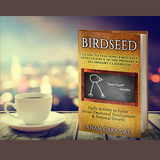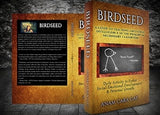MTSS: Tier One Intervention Learning Support | FREE Inspirational Writing Prompts for the ENTIRE YEAR! GRADES 6-12 | PDF Instant Download
Find the Paperback on Amazon
or Download Here for FREE!
Daily Bell-Ringer and Writing Warm-Up
+ MTSS: Tier One Intervention
Secondary Teachers and Homeschooling Parents: Enhance Your Classroom with a Positive Bell Ringer Activity!
Looking for an engaging way to start every class period? Discover Birdseed, a daily 5-10 minute activity that fosters social-emotional intelligence. Endorsed by New York Times best-selling author and positive psychology expert Shawn Achor, the Colorado Department of Education, and psychologists, teachers, and students worldwide, Birdseed is a game-changer.
Available in paperback on Amazon | Free eBook for Kindle Select members
Inside Birdseed:
- 365 Inspirational Quotes: Organized by theme for easy reference.
- Daily Usage Guide: Transform your classroom environment with these practical, daily writing prompts.
Why Birdseed?
Birdseed is more than just a collection of extraordinary quotes and journal prompts. It's a transformative tool for teachers, aimed at enhancing the classroom atmosphere and engaging students in an authentic learning process. This activity addresses the social-emotional domain, fostering a balanced approach to education that prepares students for success both in and beyond the classroom. Author and veteran teacher Anam Cara Cat bridges the gap between emotional intelligence and academic achievement, offering innovative strategies to educate, empower, and inspire today’s youth.
Benefits of Birdseed:
- Smooth transitions into class
- Daily structure and routine
- Strengthens social skills and character development
- Orients students' minds for joy and success
- Establishes communication between teacher and students
- Creates a safe and welcoming environment
- Builds a sense of community within the classroom
- Promotes critical thinking and self-awareness
- Encourages reluctant writers
- Ideal for grades 4-12
MTSS: Multi-Tiered System of Supports
Tier One Learning Intervention: Why Creating Predictable Daily Routines and Procedures is Crucial for Creating an Environment Conducive to Learning:
Establishing predictable daily routines and procedures in the classroom is crucial for creating a structured and stable learning environment. This predictability can have a profound impact on students’ nervous systems, particularly in how it affects their ability to learn and retain information.
Impact on the Nervous System:
-
Stress Reduction in The Classroom: When students know what to expect, it reduces anxiety and stress. The brain is less likely to trigger the "fight or flight" response, which is a physiological reaction to perceived threats. In this state, the body releases stress hormones like cortisol and adrenaline, which prepare the body for immediate physical action but hinder cognitive functions.
-
Turning on the “Learning Centers” in Students' Brains: The brain operates more efficiently in a relaxed state. When students feel safe and calm, the prefrontal cortex, which is responsible for higher-order thinking, problem-solving, and emotional regulation, is more active. This allows students to process information more effectively, engage in critical thinking, and perform complex tasks.
-
Reducing Hyper-vigilance in the Classroom: Students who are constantly on edge or hyper-vigilant due to unpredictable classroom environments or external factors may struggle to concentrate. Hypervigilance is a heightened state of sensory sensitivity accompanied by an exaggerated intensity of behaviors to detect threats. This state diverts cognitive resources away from learning to maintaining alertness.
Classroom Strategies:
-
Consistent Routines:
-
Start each day or class period with a consistent routine, such as a morning meeting or a bell-ringer/warm-up activity.
-
Clearly outline the schedule for the day and stick to it as closely as possible. This can be written on the board
-
Structured Procedures:
-
Establish and practice clear procedures for common activities (e.g., entering the classroom, transitioning between tasks, turning in assignments).
-
Use visual schedules or charts to remind students of these procedures.
-
Relaxation Activities:
-
Incorporate activities at the start of class that help relax the students’ nervous systems, such as deep breathing exercises, mindfulness practices, or calming music.
-
Use techniques like guided imagery or progressive muscle relaxation to help students enter a calm and focused state.
-
Predictable Transitions:
-
Signal transitions in advance and provide clear instructions on what to do next. This reduces uncertainty and keeps students feeling secure.
-
Use consistent cues or signals (e.g., a chime or hand signal) to indicate transitions.
-
Safe and Supportive Environment:
-
Create a classroom environment where students feel emotionally and physically safe. This includes addressing explicit expectations for behaviors as they relate to showing kindness and respect to one another. This also includes building strong relationships, showing empathy, and fostering a sense of community.
-
Address any behavioral issues calmly and consistently to maintain a stable environment.
Physiological and Brain Chemistry Changes:
-
Calm and Focus: When students are engaged in relaxation activities, their bodies can shift from a sympathetic nervous system response (fight or flight) to a parasympathetic response (rest and digest). This change can lower heart rates, reduce muscle tension, and decrease the levels of stress hormones.
-
Enhanced Cognitive Functioning: A relaxed state can lead to increased production of neurotransmitters like dopamine and serotonin, which are associated with mood regulation and cognitive functioning. This helps improve attention, memory, and executive functioning skills.
By creating predictable daily routines and procedures, teachers can significantly enhance students' ability to focus on instruction and learn more effectively. This structured environment helps students feel secure, reduces their stress levels, and optimizes their brain chemistry for learning. Birdseed is just one of many activities teachers in any grade or content area can use.
Insights After 14+ Years in the Secondary Classroom as an English Language Arts and Special Education teacher:
Over a decade of teaching experience has allowed me to recognize that today's youth face an epidemic of negative thinking patterns, sadness, depression, and lack of purpose. Neuroscientists and psychologists affirm that the brain can be rewired for an optimistic and proactive mindset, and our children deserve to learn these life skills. As parents and teachers, we must prioritize addressing the social-emotional domain because mental health and academic growth are interdependent. Maintaining a positive mindset and having the ability to self-regulate emotions is the foundation, and ultimately the springboard, for any definition of success.
Share the magic of Birdseed in your classroom and nourish your students' souls as well as their minds.
Much love,
Cat
This is an eBook in PDF format.
Interested in the paperback? Find it on Amazon.
Keywords to help you find me: mini-lessons, social-emotional domain, emotional intelligence, bell-ringer, daily activity, daily writing activity, inspirational activity, behavior management tools, PSHE, life-skills, The 7 Habits of Highly Effective Teens, Seven Habits, MTSS, Multi-Tiered Systems Support, PBiS






